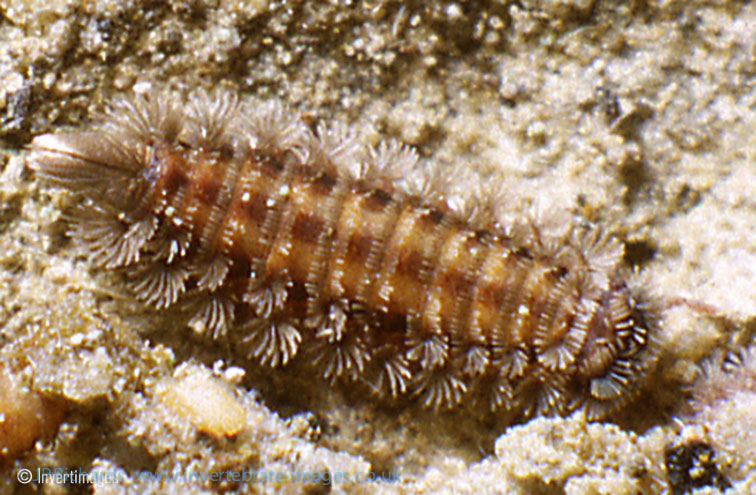Polyxenus lagurus (Linnaeus, 1758)
Common name
Status:
GB IUCN status: Least Concern
ID Difficulty
Identification
Polyxenus lagurus a very distinctive short dumpy millipede (some 2-3 mm in body length) with a pale brown body amoured with characteristic tufts and rows of bristles. When adult it has just 9 body tergites and 13 pairs of legs. It cannot be confused with any other British or Irish millipede. However, it is similar in appearance to the larva of the Cobweb Beetle Ctesias serra which inhabits similar microsites under the bark of old trees. Its small size and nocturnal habits mean that it is often overlooked.
Distribution
Polyxenus lagurus is widespread south of a line from the Severn to the Humber but is increasingly restricted to coastal sites further north.
Elsewhere the species occurs throughout Europe and also in the Central Sahara and the USA (Enghoff, 1976a; 1978).
Habitat
It occurs on old walls, on trees and in maritime habitats. In all these situations it is associated with lichens and algae on which it feeds. It can be found most readily by searching at night, especially in humid conditions, when torchlight may reveal aggregations of animals on old stone walls. In maritime habitats it occurs under mats of halophile plants, lichens and moss (Blower, 1985).
In Belgium the species occurs on old walls but also under bark and lichens on trees (Kime, 2004). Blower (1985) also stated that it was most often found under the bark of dead trees, especially conifers. However, the recording scheme's habitat data suggests a strong negative relationship with woodland. This apparent contradiction is probably explained by the ease of locating the millipede on old walls (relative to the difficulties of searching for it in woodlands) combined with the increased recording effort in churchyards over the lifetime of the recording scheme. Habitat preferences are discussed by Alexander (2006; 2010; 2012); the latter reporting its occurrence at up to 600 m a.s.l. in the Black Mountains of South Wales.
Phenology
A parthenogenetic and a sexual form of this species are reported from mainland Europe (Schömann, 1956). The British populations that have been examined appear to be of the sexual form (Fussey & Vardnell, 1980). Adults have been recorded between May and September.
This species account is based on Lee (2006).
References
Blower, J.G. 1985. Millipedes. Synopses of the British Fauna (New Series) No. 35. London: Linnean Society.
Enghoff, H. 1978. Parthenogenesis and spanandry in millipedes. Abhandlungen und Verhandlungen des Naturwissenschaftlichen Vereins in Hamburg, 21/22, 73-85.
Enghoff, H. 1976. Morphological comparison of bisexual and parthenogenetic Polyxenus lagurus (Linné, 1758) in Denmark and Southern Sweden, with notes on taxonomy, distribution and ecology. Entomologiske Meddeleleser., 44, 161-182.
Fussey, G.D. & Varndell, I.M. 1980. The identification of the sexual form of the bristly millipede, Polyxenus lagurus (Linné, 1758) at three coastal sites in England and Wales, using sex ratios. Naturalist, 105, 151-154.
Kime, R.D. 2004. The Belgian Millipede Fauna (Diplopoda). Bulletin del’Institut royal des SciencesNaturelles de Belgique, Entomologie, 74, 35-68.
Schömann, K. 1956. Zur biologie von Polyxenus lagurus (L, 1758). Zoologische Jahrbücher (Systematik), 84, 195-256.
Links
MilliBase - Global catalogue of Millipedes: https://millibase.org/aphia.php?p=taxdetails&id=151192








